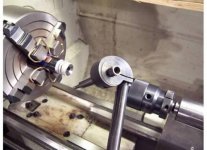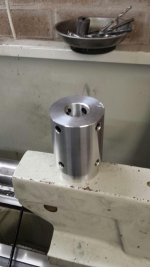You are using an out of date browser. It may not display this or other websites correctly.
You should upgrade or use an alternative browser.
You should upgrade or use an alternative browser.
Reaming Die Blanks
- Thread starter Matt P
- Start date
JerrySharrett
Senile Member
If you are talking about chambering dies, just run them in a 7/8" collet.
JerrySharrett
Senile Member
You guys are wasting a lot of effort when the press you are using them on probably is out 0.015" or so.
You guys are wasting a lot of effort when the press you are using them on probably is out 0.015" or so.
Jerry, this is just silly. You really think that press "alignment" means anything???? I mean, c'mon, you get your press all "aligned" and then you stuff a little cast-iron shellholder into a clip and jam your case into it to rattle around...... The casehead MIGHT be within a few thou before you fire it.....and then, after the case is popped out to straight it's guaranteed to be out of alignment with the case body. In many cases .003-.005 out of alignment.....
Even if you fireform cases, cull them for casehead alignment and re-turn the caseheads until they're aligned with the casebody do you really think that little shellholder clip will promote "alignment?"
Or are you referring to the "alignment" of the threaded hole to the ram?
In ANY CASE, there's no relationship between a "straight press" and the production of straight reloads.
It actually HELPS make straight cases if one loosens up the press with some abrasive paste, free that ram up to align itself....
But all that aside, STRAIGHT dies, dies that are bored and cut with a straight hole and fitted properly to the chamber will produce straight ammunition in any press capable of driving the case in and out consistently.
Conversely there ain't a press in the world that can affect the straightness of the ammo either for good or for bad. No "straight press" will help a crooked die.
For myself, I couldn't care less whether or not the outside of the die is straight but I MUST find the centerline of the hole and adjust for it.
I can't make this adjustment with a collet.
al
Now if someone makes an adjustable collet chuck, a jackable swiveling collet holder mounted to a stout backing plate then I'll switch over to Jerry's method in a heartbeat! I would LOVE to be able to collet to my die body!
JerrySharrett
Senile Member
.
For myself, I couldn't care less whether or not the outside of the die is straight but I MUST find the centerline of the hole and adjust for it.
I can't make this adjustment with a collet.
al
!
Are we takling about the same thing. I am talking about a threaded die blank that has a hole in the center and then reaming a cartridge shaped hole in it using a piloted reamer. If so, why in the hell do you need to jack the die body around??
Oh, I forgot, you are using a grizzlie lathe.
Are we takling about the same thing. I am talking about a threaded die blank that has a hole in the center and then reaming a cartridge shaped hole in it using a piloted reamer. If so, why in the hell do you need to jack the die body around??
Oh, I forgot, you are using a grizzlie lathe.
LOL!
Yeahh we are ....... I jack the die body around because I need to align the hole with the axis of the lathe, as best it can be, as they're sometimes crooked and they always have a tight end.
And just to be clear..... YES, most people stuff them into a collet or a "precision bored" 3-jaw and chew a hole in them using a reamer. That's expressly how Dave intends them to be used. He sells packages with an un-piloted "die reamer" and die blank together. I bought one, once. The reamer is still setting in the sleeve. I poked it into the hole on the die, wiggled it around like a gearshift and put it away
The difference between me and the rest of the world is, Jerry, I don't trust ANYTHING to be "straight" from minute to minute. It's a failing of mine. F'rinstance, the idea of "precision boring" a three-jaw just makes me laff.
My dies and my chambers interchange day to day, year to year. BECAUSE I don't presume anything to be "straight" nor concentric.
Now if I could just figger out how to harden the dies....... I just established yesterday that the "Ionbond" Tungsten-Carbide-Carbon vapor bonding process as offered by Springer Precision isn't an option.
JerrySharrett
Senile Member
The reamer is in a sleeve? And you are lining up on a wobbly hole? What is the OD of the die doing???
JerrySharrett
Senile Member
Whatever it wants, I can't control it. But once I've mapped out the hole I CAN make dies that all size the same.... by working off the centered up hole.
Use a floating pusher and the inside will be to spec and the outside will run true.
Use a floating pusher and the inside will be to spec and the outside will run true.
True, but the holes won't be the same size from die to die, just like rifle chambers....... Close, but not the same.......yes, this is good enough for most people, but not for me. "To spec" isn't the same as interchangeable.
I've spent a lot of money with a lot of high-end gunsmith's in my search for interchangeable chambers and dies.
I now own a lathe and can state that it ain't about "good equipment" as my ChiCom junk does give me what I need. It's a pita to work with, but it DOES get the job done. Slowly and painfully, but it gets it done.
I gave my floaters away and now ream by hand using a ho'made clamp on the reamer, pushing it with a tube. It makes chambers so small I don't pull the reamer straight out
JerrySharrett
Senile Member
I gave my floaters away and now ream by hand using a ho'made clamp on the reamer, pushing it with a tube. It makes chambers so small I don't pull the reamer straight out
I'm not talking about floating reamer holders, I said floating pushers like Mike Bryant and I use. Your pushing with a tube, that is a floating pusher!!!
Even the reamer thingy Big Bird sold is still not what I call a floating pusher.
Jay Cutright
New member
Jerry I had the big bird thingy in mind for being a floating reamer holder&pusher so I'm thinking "what is this floating reamer pusher he's a talkin about" can ya post a pic of it?
JerrySharrett
Senile Member
Jerry I had the big bird thingy in mind for being a floating reamer holder&pusher so I'm thinking "what is this floating reamer pusher he's a talkin about" can ya post a pic of it?
I'll try to tomorrow. I think Mike Bryant may have one on his site. Nope, Gebharts doesn't float like they need to.
Note- the pusher has about 1/64" clearance over the reamer body. This allows the reamer to move to the centerline of barrel rotation regardless of the tailstocks alignment with the spindle.


Last edited:
I'll try to tomorrow. I think Mike Bryant may have one on his site. Nope, Gebharts doesn't float like they need to.
here's what I push
http://im1.shutterfly.com/media/47a...9905547210023211.JPG/ps=50/r=0/rx=550/ry=400/

JerrySharrett
Senile Member
Jerry,
I'm having trouble getting my mind around your quote that the Bald Eagle's don't "float like they need to". Can you explain why the pusher that you and others use does, but the Bald Eagle does not?
Thanks,
Justin
The only Bald Eagle I've seen pushes from a sphericale surface (i.e. a point) which doesn't allow the reamer to easily shift when it is under load, IMO, as a pusher that has the pushing force spread over a larger area which allows the reamer shift if it needs to in setups where the tailstock is not perfectly aligned with the center of rotation of the barrel.
None of the smaller lathes have tailstocks that stay perfectly aligned with the center of spindle rotation because the little lathe bed is constantly flexing even if they are on a 12" concrete foundation. Put a precision laser level on them and watch the movement. Even just opening a door or the AC/heat air flow causes bed movement which translates to tailstock movement. Any time the tailstocks quill protrusion is not pointing exactly down the spindles axis of rotation the movement would cause the reamer to shift off its axis of penetration.
Plus, with the pusher setup as Jerry describes (I don't know who came up with it but I just copied his idea) when stuff goes out of line the pushing force automatically shifts to the "high side" to compensate!
friggin genius
This is so far much better than the Brownell's School Of Gunsmithing I went to school for that I bought a lathe JUST BECAUSE with this system you don't need to be constantly babysitting a quarter or half million dollars to "cut straight." Between this and the "Gordy Style" indicator extension I can individually dial in each and every setup and never have to trust the mo'chine.
I don't trust nuttin
al
friggin genius
This is so far much better than the Brownell's School Of Gunsmithing I went to school for that I bought a lathe JUST BECAUSE with this system you don't need to be constantly babysitting a quarter or half million dollars to "cut straight." Between this and the "Gordy Style" indicator extension I can individually dial in each and every setup and never have to trust the mo'chine.
I don't trust nuttin
al


